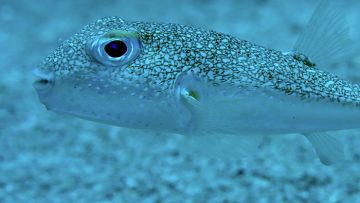A few years ago, I wrote a blog on the amazing “spider-tailed viper” – a snake with a tail shaped like a spider that it twitched, likely to attract prey. That blew me away – the manner in which selection had presumably shaped the animal’s body and behaviour. Much to my surprise, my friend and colleague Tom Quinn at the University of Washington recently alerted me to something even more amazing – the fish as an artist!
Pufferfishes are a group of about 120 species of mostly marine fishes (some have colonized fresh water) best known for their ability to “puff-up” as a defense against predators, as well as for their toxic internal organs and skin. A new species from Japan is now becoming known for its fascinating mating habits.

Image Source: BBC
Like most animals, pufferfishes need to attract mates for successful breeding. There are many ways that males can do this. Often males have elaborate morphological features used in mate attraction or mating competition, like the peacock’s tail or the horns of the rhinoceros beetle. In fishes, males are often spectacularly-coloured, which may help to attract females – think of the bright green heads and red bodies of male sockeye salmon. One species of pufferfish found in Japan, however, is relatively drably-coloured, seemingly to match its sandy environment. So how does this fish attract a mate? This pufferfish has gone to extraordinary efforts to use other means to attract females – it creates what could easily be interpreted as “sand art.”
A short video by BBC describes this remarkable behaviour and its result – a stunning sand sculpture (especially around 2 min 10 s onwards). The male fish uses its remarkably flexible fins to create this attraction; changes in fin shape and flexibility are likely a key innovation in the history of fishes that has resulted in myriad amazing behaviours and morphological features. Such behaviour and its consequences for the puffer’s immediate environment are a good example of what Richard Dawkins described as the extended phenotype, which is the idea that an organism’s genes can also influence its environment; more common examples include beaver dams, or how some parasites may affect their hosts.
Wow, and I thought the viper-tailed spider was amazing!
